Perhaps the most important dimension to the National Championship game is how well Clemson can hold up against LSU’s precision strikes. A big part of the Big 12 game, at least in seasons when particular teams have good QB play, is the college game’s equivalent of the “precision strike.”
That’s a military term for weapons that can hit particular targets in a crowded area, as opposed to the WWII “total war” strategy in which entire cities would be heavily bombed in hopes of breaking the factories. It’s a bit of a game changer for war and there have been some big changes to the way that football is played as well due to the practice.
Art Briles did a lot to push forward the college football “precision strike” with his Baylor offenses in the early part of the decade. I chronicle his system and the impact in my book…
…and the rest of the Big 12 caught on in the wake of his back to back league championships that this was the right way to attack teams.
The method is essentially to use spread formations, the threat of the run game (sometimes), and route combinations to isolate particular defenders against your best deep threat receivers running adjustable routes into open space.
Lincoln Riley basically picked up where Briles left off and unleashed Dede Westbrook, Marquise Brown, and CeeDee Lamb/Charleston Rambo in that system over the last few years. However, Jalen Hurts isn’t very good at it so the Sooners didn’t have their normal potency this season.
LSU now employs this approach in their offense now and they bludgeoned the SEC and then gave Oklahoma a bitter taste of their own medicine in the semifinal. Here’s an early RPO they ran to great effect:
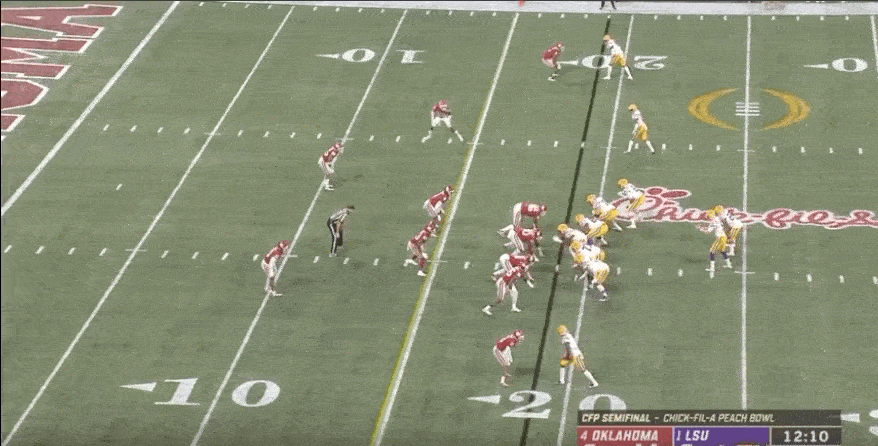
Tough look here for Marcus Stripling, who gets knocked off the ball by the tackle and then picked up by the TE while the RT continues his march. This is basically when you knew it was over for the Sooners. Brendan Radley-Hiles couldn’t cover Justin Jefferson on this slant and Stripling and the DL wasn’t going to hold up against LSU’s power run game without the strong safety flying down as Justin Broiles did here.
The Tigers had some more devastating ways to hit them though:
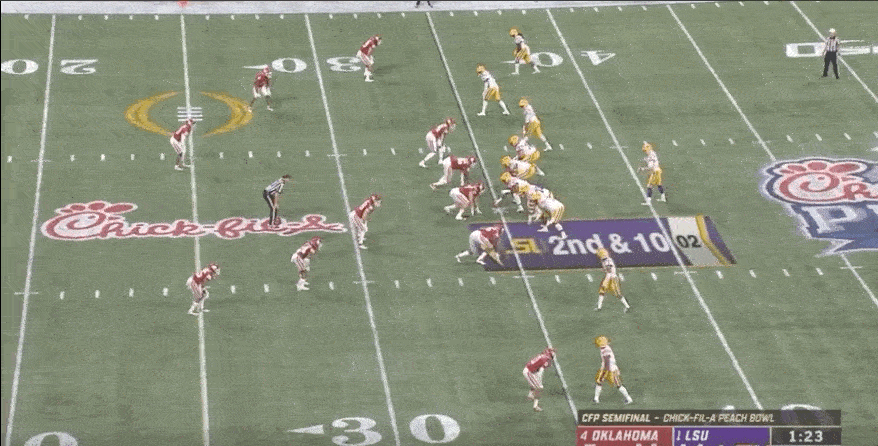
Here’s the design on the chalkboard.
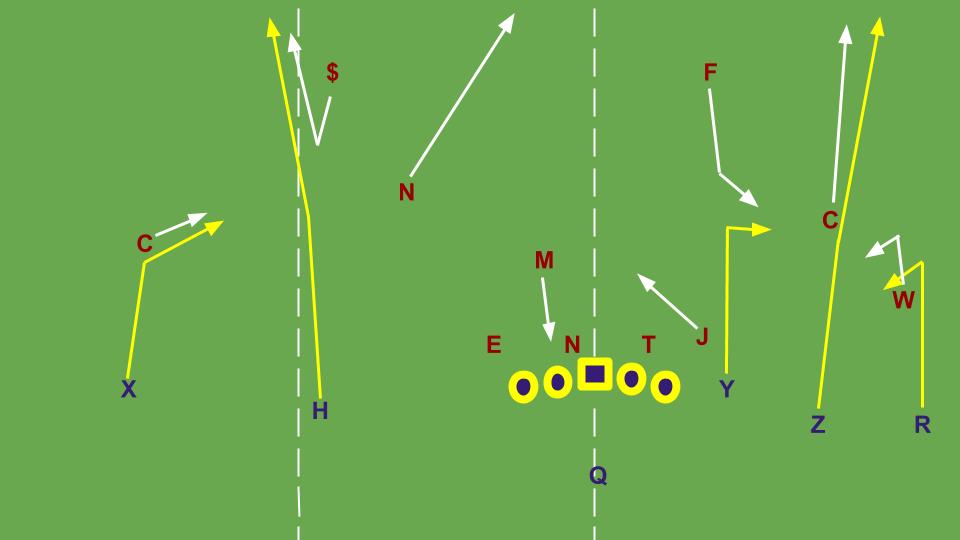
LSU is in 11 personnel here (3 WRs, 1 TE, 1 RB), which is part of what makes their offense so devastating. They can get into their “duo” power run game or they can get into empty spread passing sets from the same personnel group and hurry to the line so that you can’t huddle. This is what made Texas extra effective in 2018 as well, although Texas didn’t run many concepts like this and often used it either to throw option routes to Lil’Jordan Humphrey or to convert short-yardage with Sam Ehlinger.
Matching up against 4/5-wide empty sets from nickel personnel is truly difficult and figuring out how to do that (from base 4-3, actually) was a big reason that Oklahoma won the 2018 Big 12 championship against Texas. Wasn’t happening here.
The concept is double slot fades, on the right side LSU is running the slot fade attached to “Y-stick” with the TE running the stick option route and the RB flexed out wide to run the hitch designed to hold the cornerback. I’m old enough to remember when teams used to run Y-stick in order to throw to the Y receiver…the Colt McCoy Longhorns were built from that play after moving Shipley to the Y position.
Oklahoma doesn’t fall for this, they flex out will LB Caleb Kelly to match up with the RB running the hitch route rather than wasting LCB Tre Brown and then Brown does a good job of matching and denying the slot fade by Terrace Marshall, Jr.
The coverage by Oklahoma is Saban’s rip/liz cover 3 pattern matching system. The way they get there is interesting and a scheme they used all year, dropping nickel Brendan Radley-Hiles to the deep middle while either safety drops down to match the slots in the seams. Patrick Fields the free safety comes down and matches the stick route effectively…there’s just one more problem.
Justin Jefferson is to the other side of the field running a slot fade on Justin Broiles. Brendan Radley-Hiles dropping late to the deep middle with eyes to the trips side can’t help on that, probably couldn’t have helped on that even if he’d opened to Jefferson’s side, and it’s a TD.
The Sooners ran out of good coverage defenders against that formation to get the kind of matchup they needed against Jefferson. Honestly Alex Grinch did a poor job of producing answers for matching up with Justin Jefferson in this game. The man had 102 targets for 1207 yards and 14 touchdowns this year, you knew that he was a problem and that your nickel/strong safety position was going to be a trouble spot even before Delarrin Turner-Yell was lost with injury in bowl practices.
However, the Sooners repeatedly allowed the Tigers to isolate Jefferson on Broiles (even before Radley got the boot) and my man had 14 catches for 227 yards and four touchdowns. Domination.
The Tigers hardly had to do anything else but throw to Jefferson matched up on Broiles or Radley-Hiles in space to win this game. Precision strikes vs a targeted weak spot down the field, that’s what really makes this LSU team deadly.
Sending in the drones vs Brent Venables
LSU isn’t going up against Oklahoma’s iffy secondary or less experienced Alex Grinch in the final though. This time they draw Clemson, Brent Venables, and probably the inverted Tampa 2 package that they used to beat Ohio State in the other semifinal.
However, the rip/liz cover 3 scheme that I diagrammed LSU torching with the double slot fades concept is similar to the one that Clemson tended to play a lot from their IT2/dime package. But because the Venables were in dime they have four safeties and two corners to use in matching up against the threats where the Sooners had three safeties and two cornerbacks (shoulda played dime, Alex). Clemson also played a lot of cover 3 buzz from that scheme, which works a little differently:
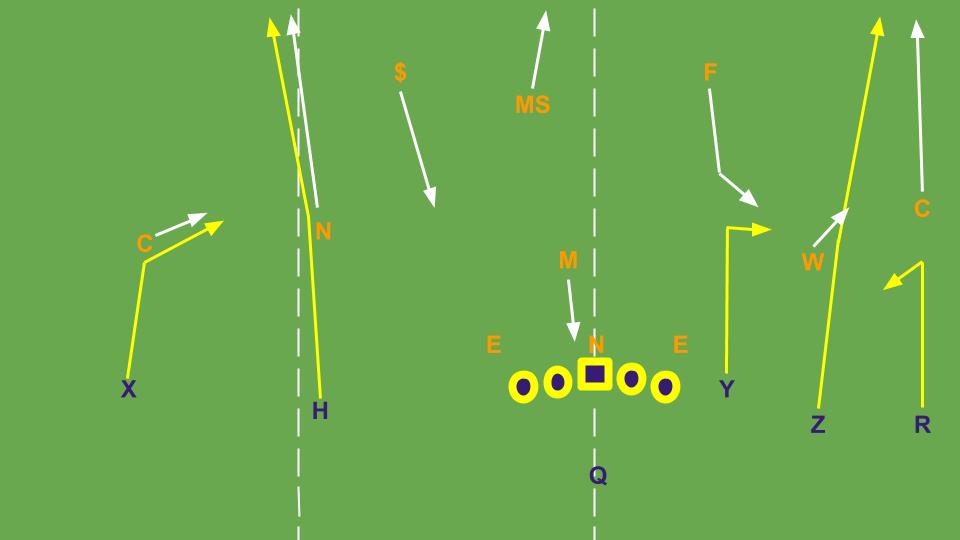
Clemson would tend to drop the safeties Tanner Muse and Nolan Turner to play the hook zones while playing the curl-to-flat zones with the linebackers. Well, from that set-up you can have the boundary corner carry the deep 1/3 vs the Z slot fade with help in the middle from Isaiah Simmons and then you have nickel K’Von Wallace carrying the vertical route by the H (Jefferson).
In cover 3 buzz it’s harder to get the easy pickings down the field, if you move your better receivers further inside to hunt the safeties then they have more help from Simmons over the top.
What you want is to catch Clemson in quarters coverages where Turner and Muse have to carry vertical routes by slot receivers, but I’m guessing that Venables won’t give LSU many opportunities to do that. Perhaps he’ll also have the actual inverted Tampa 2 coverage installed for this game, they ran some normal Tampa 2 from this package against Ohio State with a middle linebacker dropping up the middle. I’m guessing they could have the other version ready to go where Isaiah Simmons is the middle defender:
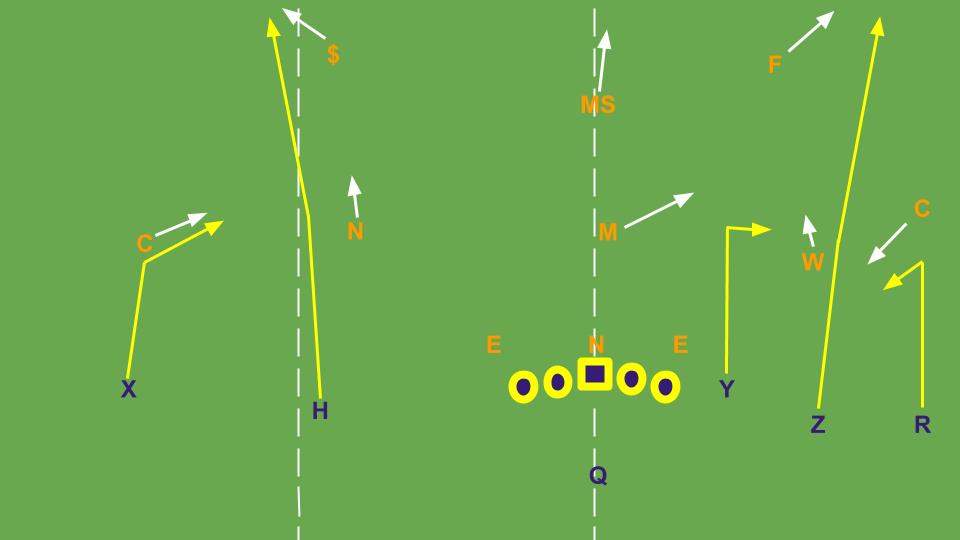
The main goal of inverted Tampa 2 is to remove the ability for offenses to launch precision strikes by running their best receivers into open grass down the field against isolated defenders. In this coverage you get Muse and Turner sitting on top of the routes with help inside from Simmons, it’s not a good place to go. Instead the Tigers would have to work their way down the field throwing underneath on the nickel, cornerbacks, and linebackers.
That philosophy is how Venables has been playing these playoff games against explosive spread offenses. Against Alabama and Ohio State he forced them to work their way down the field and then convert in the red zone. Texas didn’t play LSU this way and were burned, Auburn had some packages but they still allowed the Tigers to isolate their corners down the field. If Venables takes away these sorts of downfield strikes, Clemson can win this game.

I’m curious how much it will matter. Rewatching the game, OU generally did a lot better than I remembered watching it live. It’s just that Burrow is so good at finding an opening, even if he’s under pressure, that getting into the backfield and having defenders in the vicinity of the receivers isn’t enough.
OU didn’t do a good job of protecting themselves from bad matchups or getting help against Jefferson.
I guess, but even in times when OU did, Burrow still made the throws and the receivers still made the catch, generally speaking.
I don’t think Grinch felt like he had 6 competent DBs to put on the field to play dime. He really didn’t even have 5.
I don’t really understand the Grinch criticism coming from the review of the tape of this game lately. Do you really feel like any defensive coordinator in the country could have put this OU roster in a better position against that LSU offense?
Shoulda played an extra corner or made sure they always had a double on Jefferson so LSU couldn’t get those gimmes.
His specialty is out scheming people up front, on the back end he got played.
Ian, did you see how far upfield the officiating let LSU get on their rpos? Clip above should be a flag almost every time, and yet it isn’t called consistently. Do you feel like officials should be calling illegal man downfield and offensive pi more frequently?
A little borderline, you get 3 yards in college. Most defensive fronts don’t get driven so hard and far off the ball. Maybe we shouldn’t hold it against LSU that OU couldn’t hold the point of attack for more than a second.
The 2019 LSU Tigers: The ultimate “Space Force” – Concerning Sports
[…] most devastating weaponry in LSU’s “Space Force” is their precision strike capacity that I detailed in one of my previews. The LA Tigers have a real knack for using tempo and 11 personnel to get into wide open spread sets […]